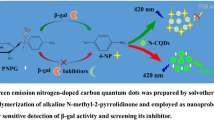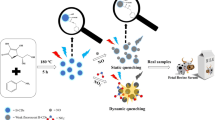Abstract
Fluorescent nitrogen and phosphorus co-doped carbon dots (NPCDs) were prepared via a hydrothermal method with citric acid and O-phosphorylethanolamine as precursors. The overlap between the absorption spectrum of riboflavin and the fluorescence emission spectrum of the NPCDs and the relative proximity of the NPCDs to riboflavin due to hydrogen bonding facilitated the formation of a NPCDs/riboflavin fluorescence resonance energy transfer (FRET) system. Thus, a ratiometric fluorescence method for the detection of riboflavin based on the formation of this NPCDs/riboflavin FRET system was developed. The method displayed a sensitive and selective response to riboflavin in the range 0.5–50 μmol/L with a detection limit of 0.17 μmol/L. It was also found to be suitable for the detection of riboflavin in milk and riboflavin pharmaceutical tablets.

Illustration of the preparation of NPCDs and the ratiometric fluorescence detection of riboflavin using the NPCDs/riboflavin FRET system




Similar content being viewed by others
References
Han J, Zou HY, Gao MX, Huang CZ. A graphitic carbon nitride based fluorescence resonance energy transfer detection of riboflavin. Talanta. 2016;148:279–84.
Kundu A, Nandi S, Layek RK, Nandi AK. Fluorescence resonance energy transfer from sulfonated graphene to riboflavin: a simple way to detect vitamin B2. ACS Appl Mater Interfaces. 2013;5:7392–9.
Hu L, Yang XP, Wang CL, Yuan HY, Xiao D. Determination of riboflavin in urine and beverages by capillary electrophoresis with in-column optical fiber laser-induced fluorescence detection. J Chromatogr B. 2007;856:245–51.
Wang P, Yin YM, Eremin SA, Rybakov VB, Zhang TC, Xu ZH, et al. Indirect competitive immunoassay for detection of vitamin B2 in foods and pharmaceuticals. J Agric Food Chem. 2013;61:7048–54.
Petteys BJ, Frank EL. Rapid determination of vitamin B2 (riboflavin) in plasma by HPLC. Clin Chim Acta. 2011;412:38–43.
Stanković DM, Kuzmanović D, Mehmeti E, Kalcher K. Sensitive and selective determination of riboflavin (vitamin B2) based on boron-doped diamond electrode. Chem. 2016;147:995–1000.
Ma Q, Song JP, Zhang SF, Wang MF, Guo Y, Dong C. Colorimetric detection of riboflavin by silver nanoparticles capped with β-cyclodextrin-grafted citrate. Colloid Surface B. 2016;148:66–72.
Hucker B, Wakeling L, Vriesekoop F. The quantitative analysis of thiamin and riboflavin and their respective vitamers in fermented alcoholic beverages. J Agric Food Chem. 2011;59:12278–85.
Li DJ, Bie ZJ, Wang FF, Guo EH. Efficient synthesis of riboflavin-imprinted magnetic nanoparticles by boronate affinity-based surface imprinting for the selective recognition of riboflavin. Analyst. 2018;143:4936–43.
Bhattar SL, Kolekar GB, Patil SR. Fluorescence resonance energy transfer between perylene and riboflavin in micellar solution and analytical application on determination of vitamin B2. J Lumin. 2008;128:306–10.
Wang JL, Su SH, Wei JH, Bahgi R, Hope-Weeks L, Qiu JJ, et al. Ratio-metric sensor to detect riboflavin via fluorescence resonance energy transfer with ultrahigh sensitivity. Phys E. 2015;72:17–24.
Sapsford KE, Berti L, Medintz IL. Materials for fluorescence resonance energy transfer analysis: beyond traditional donor–acceptor combinations. Angew Chem Int Edit. 2006;45:4562–89.
Lakowicz JR. Principles of fluorescence spectroscopy. 3rd ed. Berlin: Springer; 2006.
Xu ZC, Xiao Y, Qian XH, Cui JN, Cui DW. Ratiometric and selective fluorescent sensor for CuII based on internal charge transfer (ICT). Org Lett. 2005;7:889–92.
Jiang J, Jiang HE, Liu W, Tang XL, Zhou X, Liu WS, et al. A colorimetric and ratiometric fluorescent probe for palladium. Org Lett. 2011;13:4922–5.
Lin LP, Wang YH, Xiao YL, Liu W. Hydrothermal synthesis of nitrogen and phosphorus co-doped carbon dots as a turn-on fluorescence probe for cadmium(II). Microchim Acta. 2019;186:147.
Li GL, Kong WH, Zhao M, Lu SM, Gong PW, Chen G, et al. A fluorescence resonance energy transfer (FRET) based “turn-on” nanofluorescence sensor using a nitrogen-doped carbon dot-hexagonal cobalt oxyhydroxide nanosheet architecture and application to alpha-glucosidase inhibitor screening. Biosens Bioelectron. 2016;79:728–35.
Manna S, Saha A, Nandi AK. A two component thermoreversible hydrogel of riboflavin and melamine: enhancement of photoluminescence in the gel form. Chem Commun 2006;41:4285–7.
Wang J, Wang CF, Chen S. Amphiphilic egg-derived carbon dots: rapid plasma fabrication, pyrolysis process, and multicolor printing patterns. Angew Chem Int Edit. 2012;51:9297–301.
Russell LF, Brooks L, McRae KB. Development of a robotic-HPLC determination of riboflavin vitamers in food. Food Chem. 1998;63:125–31.
Eitenmiller RR, Jr WOL, Ye L. Vitamin analysis for the health and food sciences. 2nd ed. Boca Raton: CRC Press; 2008.
Funding
This research work was financially supported by the Natural Science Foundation from Science and Technology, Department of Fujian Province (no. 2018J05013), Educational Research Projects for Young and Middle-Aged Teachers of Fujian Province (no. JT180136), and the Outstanding Youth Research Training Program of Fujian Agriculture and Forestry University (no. xjq201818), which are gratefully acknowledged.
Author information
Authors and Affiliations
Corresponding author
Ethics declarations
Conflicts of interest
The authors declare that they have no conflict of interest.
Additional information
Publisher’s note
Springer Nature remains neutral with regard to jurisdictional claims in published maps and institutional affiliations.
Rights and permissions
About this article
Cite this article
Lin, L., Wang, Y., Xiao, Y. et al. Ratiometric fluorescence detection of riboflavin based on fluorescence resonance energy transfer from nitrogen and phosphorus co-doped carbon dots to riboflavin. Anal Bioanal Chem 411, 2803–2808 (2019). https://doi.org/10.1007/s00216-019-01725-1
Received:
Revised:
Accepted:
Published:
Issue Date:
DOI: https://doi.org/10.1007/s00216-019-01725-1




